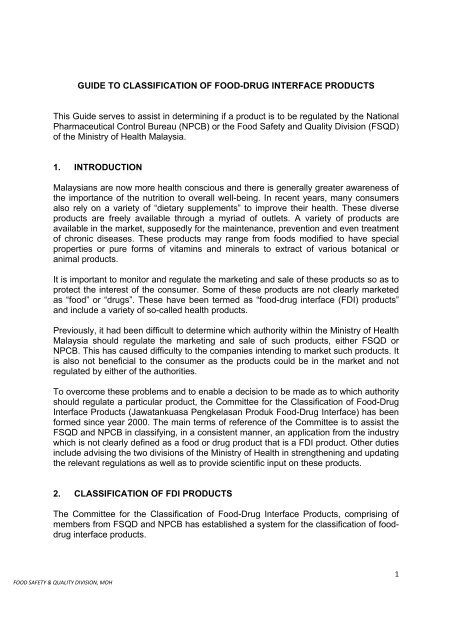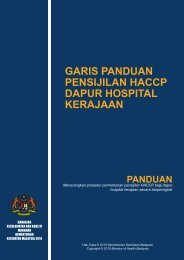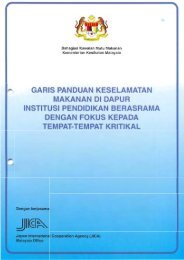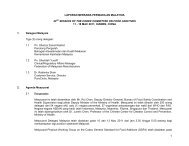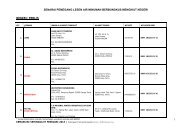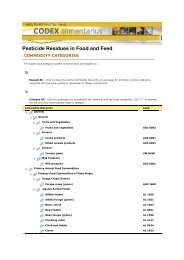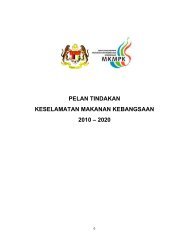GUIDE TO CLASSIFICATION OF FOOD-DRUG INTERFACE ...
GUIDE TO CLASSIFICATION OF FOOD-DRUG INTERFACE ...
GUIDE TO CLASSIFICATION OF FOOD-DRUG INTERFACE ...
Create successful ePaper yourself
Turn your PDF publications into a flip-book with our unique Google optimized e-Paper software.
<strong>FOOD</strong> SAFETY & QUALITY DIVISION, MOH<br />
<strong>GUIDE</strong> <strong>TO</strong> <strong>CLASSIFICATION</strong> <strong>OF</strong> <strong>FOOD</strong>-<strong>DRUG</strong> <strong>INTERFACE</strong> PRODUCTS<br />
This Guide serves to assist in determining if a product is to be regulated by the National<br />
Pharmaceutical Control Bureau (NPCB) or the Food Safety and Quality Division (FSQD)<br />
of the Ministry of Health Malaysia.<br />
1. INTRODUCTION<br />
Malaysians are now more health conscious and there is generally greater awareness of<br />
the importance of the nutrition to overall well-being. In recent years, many consumers<br />
also rely on a variety of “dietary supplements” to improve their health. These diverse<br />
products are freely available through a myriad of outlets. A variety of products are<br />
available in the market, supposedly for the maintenance, prevention and even treatment<br />
of chronic diseases. These products may range from foods modified to have special<br />
properties or pure forms of vitamins and minerals to extract of various botanical or<br />
animal products.<br />
It is important to monitor and regulate the marketing and sale of these products so as to<br />
protect the interest of the consumer. Some of these products are not clearly marketed<br />
as “food” or “drugs”. These have been termed as “food-drug interface (FDI) products”<br />
and include a variety of so-called health products.<br />
Previously, it had been difficult to determine which authority within the Ministry of Health<br />
Malaysia should regulate the marketing and sale of such products, either FSQD or<br />
NPCB. This has caused difficulty to the companies intending to market such products. It<br />
is also not beneficial to the consumer as the products could be in the market and not<br />
regulated by either of the authorities.<br />
To overcome these problems and to enable a decision to be made as to which authority<br />
should regulate a particular product, the Committee for the Classification of Food-Drug<br />
Interface Products (Jawatankuasa Pengkelasan Produk Food-Drug Interface) has been<br />
formed since year 2000. The main terms of reference of the Committee is to assist the<br />
FSQD and NPCB in classifying, in a consistent manner, an application from the industry<br />
which is not clearly defined as a food or drug product that is a FDI product. Other duties<br />
include advising the two divisions of the Ministry of Health in strengthening and updating<br />
the relevant regulations as well as to provide scientific input on these products.<br />
2. <strong>CLASSIFICATION</strong> <strong>OF</strong> FDI PRODUCTS<br />
The Committee for the Classification of Food-Drug Interface Products, comprising of<br />
members from FSQD and NPCB has established a system for the classification of fooddrug<br />
interface products.<br />
1
This classification is based on multiple criteria, as outlined below:<br />
2.1 Main criteria<br />
<strong>FOOD</strong> SAFETY & QUALITY DIVISION, MOH<br />
The ingredients of the product are the main criteria of this classification process:<br />
2.1.1 If the product content close to 100% of active ingredients, e.g. amino acids<br />
& peptides, collagen, coral calcium, dietary fibre, enzymes, fatty acids, live<br />
microorganism, minerals, plant stanol/sterol & esters, vitamins, etc, the<br />
product has to be regulated by NPCB.<br />
2.1.2 Substances or ingredients used for therapeutic purposes shall not be<br />
added to food.<br />
2.1.3 A product content close to 100% of a herb or a mixture of herbs that are not<br />
traditionally used as food and possess medicinal values if shall be<br />
regulated by NPCB. Examples of such products are aloe vera, alfalfa*,<br />
barleygrass, dukung anak, gamat extract, kacip fatimah, manjakani, mas<br />
cotek, misai kucing, noni extract, royal jelly, spirulina, tongkat ali, tunjuk<br />
langit, wheatgrass, psyllium husk, pegaga tablet, rooibos tea*.<br />
2.1.4 Herbs and spices that are traditionally used in food preparation shall be<br />
regulated by FSQD e.g black cumin (habbatus sauda), garlic, ginger,<br />
pegaga, traditional chinese raw herbs, turmeric.<br />
2.1.5 Products containing a mixture of food ingredients with active ingredients<br />
and/or herbs identified in 2.1.3 and 2.1.4 above shall be classified<br />
according to the 80:20 ratio general rule below, unless otherwise specified<br />
a. If a product contains more than 20% of the active ingredients or<br />
natural ingredients with pharmacological and/or therapeutic properties,<br />
such a product shall be regulated by NPCB.<br />
b. If a product contains equal to or less than 20% of active ingredients or<br />
natural ingredients with pharmacological and/or therapeutic properties,<br />
the product shall be regulated by FSQD.<br />
c. Not withstanding this general rule, if a product contains specific active<br />
ingredients which possess high pharmacological or therapeutic<br />
potencies, the product may be regulated by NPCB even if these active<br />
ingredients are present in less than 20%<br />
2.1.6. When there is greater uncertainty regarding the safety of a product, it shall<br />
be regulated by NPCB. This is to enable closer monitoring of such<br />
products, so as to safeguard the interest of the consumer.<br />
2
<strong>FOOD</strong> SAFETY & QUALITY DIVISION, MOH<br />
2.1.7. Not withstanding the above points, the following ingredients do not follow<br />
the 80:20 ratio general rule mentioned above and shall be regulated by<br />
NPCB:<br />
2.2 Other criteria<br />
• Plant sterols/stanols and esters that are consumed ≥ 3.5g/day<br />
• Psyllium husk that are consumed ≥ 3.5g/day<br />
The following may be used as additional criteria to assist in the classification of<br />
FDI products:<br />
2.2.1 Intended use and claims made by the product.<br />
Eventually, if a product has been decided to be regulated by FSQD, no<br />
claims should be made, other than those permitted by the Food<br />
Regulations.<br />
2.2.2 Dosage form.<br />
• Any foods or combination of foods that are regulated under FSQD<br />
shall not be in the form of softgel, capsule or tablet that are to be<br />
directly swallowed.<br />
• Any product to be regulate under NPCB shall not be in the<br />
conventional food form such as cake, muffins, biscuits, gummy,<br />
jelly, chocolate, premix beverages etc<br />
2.2.3 Unusual application.<br />
Products with unusual application for example spray may not be accepted<br />
by FSQD.<br />
2.2.4 Oils in pharmaceutical dosage form.<br />
Oils that are not traditionally used as food or are in combination with edible<br />
oil for example evening primrose oil, garlic oil, fish oil, flaxseed oil and<br />
grapeseed oil in capsule or softgel shall be regulated by NPCB.<br />
3
Key<br />
Content close to<br />
100% active<br />
ingredients (singly or<br />
in combination)<br />
(E.g.)<br />
• Amino Acids &<br />
Peptides<br />
• Collagen<br />
• Coral calcium<br />
• Dietary Fibre 2<br />
• Enzymes<br />
• Fatty Acids<br />
• Live micro<br />
organism 3,4<br />
• Minerals<br />
• Plant<br />
Stanol/Sterol &<br />
Esters<br />
(≥3.5g/day)<br />
• Vitamins<br />
BKKM/FSQD<br />
BPFK/NPCB<br />
<strong>FOOD</strong> SAFETY & QUALITY DIVISION, MOH<br />
3. PIC<strong>TO</strong>RIAL <strong>GUIDE</strong> <strong>TO</strong> <strong>CLASSIFICATION</strong> <strong>OF</strong> <strong>FOOD</strong>-<strong>DRUG</strong> <strong>INTERFACE</strong> PRODUCTS<br />
Substances or<br />
ingredients that are<br />
used for therapeutic<br />
purposes shall not<br />
be added to food<br />
(E.g.)<br />
• Gypsum<br />
fibrosum<br />
• Pearl Powder<br />
• Gamat Extract<br />
Content close to<br />
100% herbs (singly<br />
or in combination)<br />
that are not<br />
traditionally used as<br />
food and have<br />
medicinal property<br />
(E.g)<br />
• Alfalfa<br />
• Aloe vera<br />
• Barleygrass<br />
• Dukung Anak<br />
• Kacip Fatimah<br />
• Manjakani<br />
• Mas Cotek<br />
• Misai Kucing<br />
• Noni Extract<br />
• Royal Jelly<br />
• Spirulina<br />
• Tongkat Ali<br />
• Tunjuk Langit<br />
• Wheatgrass<br />
• Psyllium<br />
Husk(≥3.5g/day)<br />
Product<br />
Ingredient 1<br />
Herbs & spices that<br />
are traditionally used<br />
in food preparations<br />
(E.g)<br />
• Black cumin<br />
(Habbatus<br />
sauda)<br />
• Garlic<br />
• Ginger<br />
• Pegaga<br />
• Traditional<br />
Chinese Raw<br />
Herbs<br />
• Turmeric<br />
More than 20%<br />
active ingredients<br />
with<br />
pharmacological/<br />
therapeutic<br />
properties, singly or<br />
in combination.<br />
Mixtures of food<br />
ingredients with<br />
active ingredients<br />
and/or herbs<br />
≤ 20% of active<br />
ingredients or<br />
natural ingredients<br />
with pharmacological<br />
and/or therapeutic<br />
properties.However<br />
if a product contains<br />
specific active<br />
ingredients which<br />
possess high<br />
pharmacological or<br />
therapeutic<br />
potencies, the<br />
product may be<br />
regulated by BPFK<br />
even if these active<br />
ingredients are<br />
present in less than<br />
20%<br />
4
<strong>FOOD</strong> SAFETY & QUALITY DIVISION, MOH<br />
1. Substances listed in the prohibited ingredient list of the Drug Registration<br />
Guidance Document (DRGD) and Schedule Poison shall not be permitted for use<br />
in any product.<br />
2. Dietary fibre includes inulin, fructooligosacharrides, galactooligosacharrides,<br />
polydextrose, acacia gum, oat soluble fibre, resistant dextrose and resistant<br />
maltodextrine.<br />
3. Permitted live microorganism when present by itself singly or in combination in<br />
pharmaceutical dosage form shall be regulated under NPCB and shall contain<br />
minimum 10 6 cell/g of the viable cells for each strain.<br />
4. Permitted live microorganism when present in foods shall be treated as food<br />
ingredient and shall contain minimum 10 6 viable cells/g of the viable cells<br />
depending on the strains.<br />
5
4. ADDITIONAL GUIDANCE NOTES FOR <strong>FOOD</strong> PRODUCTS<br />
4.1 Foods<br />
According to Clause 2 of the Food Act 1983,<br />
"Food" includes every article manufactured, sold or represented for use as food or drink<br />
for human consumption or which enters into or is used in the composition, preparation,<br />
preservation, of any food or drink and includes confectionery, chewing substances and<br />
any ingredient of such food, drink, confectionery or chewing substances.<br />
All food products must comply with the Food Act 1983 and Food Regulations 1985<br />
4.2 List of Food Products that may contain Herbs or Botanical Plants under<br />
Food Regulations 1985<br />
<strong>FOOD</strong> SAFETY & QUALITY DIVISION, MOH<br />
1. Meat extract or meat essence<br />
2. Botanical Beverage Mix (regulation 356)<br />
3. Mixed Food Products<br />
4. Food standards that contain words: “may contain other food”<br />
4.3 Permitted Added Nutrients in Food Products<br />
Please refer to Table I of the TWELFTH SCHEDULE, Food Regulations 1985<br />
4.4 Maximum Amounts of Vitamins and Minerals permitted in Food<br />
Added Nutrient Maximum amount in<br />
recommended daily serving<br />
Vitamin A 5,000 I.U.<br />
Thiamine 2.2 milligram<br />
Riboflavin 3.2 milligram<br />
Pyridoxine 4 milligrams<br />
Biotin 400 micrograms<br />
Pantothenic acid 14 milligrams<br />
Niacin 22 milligrams<br />
Ascorbic acid 100 milligrams<br />
Vitamin D 800 I.U.<br />
Vitamin E 50 I.U.<br />
Calcium 1.4 grams<br />
6
<strong>FOOD</strong> SAFETY & QUALITY DIVISION, MOH<br />
Iodine 200 micrograms<br />
Iron 20 milligrams<br />
Phosphorus 1.4 grams<br />
Folic acid 400 micrograms<br />
Vitamin B12<br />
4.5 Permitted Bifido Bacteria in Food<br />
4 micrograms<br />
PERMITTED BIFIDO BACTERIA IN <strong>FOOD</strong><br />
Name Minimum viable cells/g<br />
Bifido bacterium lactis (L-form) 10 6<br />
Bifido bacterium longum (L-form) 10 6<br />
Updated on 9 August 2012<br />
7


